Front End Vs Back End Web Development: Front-end development focuses on the user interface, while back-end development deals with server-side functionalities. Automated Testing Vs Manual Testing: Automated testing involves using tools to execute test cases, while manual testing requires human intervention to manually execute test cases.
Front-end and back-end web development are two crucial aspects of building a website or web application. Front-end development involves creating the user interface that users interact with, while back-end development deals with the server-side functionalities that support the front-end. Automated testing is a method of testing software using tools and scripts to execute test cases, while manual testing relies on human intervention to manually execute test cases.
Both automated and manual testing have their advantages and are used in different scenarios to ensure the quality and functionality of a website or application. We will explore the differences between front-end and back-end development, as well as the pros and cons of automated and manual testing.
Automated Testing For Front End Development
Automated frontend testing in web development involves checking how the UI responds to different inputs, actions, devices, browsers, and screen sizes. This type of testing can be done manually or automatically using tools like Selenium, Cypress, or Jest. Automated front end testing tools are very helpful and are improving all the time.
Advantages of automated testing in front end development:
- Efficiency: Automated tests can run faster and more frequently than manual tests.
- Accuracy: Automated tests can execute test cases precisely and repeatedly without human error.
- Scalability: Automated tests can be easily applied to a large number of test cases and scenarios.
- Consistency: Automated tests produce consistent results, ensuring that the application functions as expected across different environments.
- Regression testing: Automated tests help identify issues introduced during code changes or updates.
Popular tools and frameworks for automated testing in front end development:
| Tool/Framework | Description |
|---|---|
| Selenium | A widely used tool for automating web browsers in frontend testing. |
| Cypress | A JavaScript-based end-to-end testing framework for modern web applications. |
| Jest | A JavaScript testing framework with built-in support for frontend testing. |

Credit: www.accelq.com
Manual Testing For Front End Development
Manual testing for front-end development involves checking how the user interface responds to different inputs, actions, browsers, and devices. It can be done manually or automated using tools like Selenium, Cypress, or Jest. Automated front-end testing tools are continuously improving and can be very helpful in ensuring the quality of front-end development.
Definition And Purpose Of Manual Testing In Front End DevelopmentManual testing in front end development refers to the process of manually examining and evaluating the functionality, usability, and performance of a front end application. This type of testing is performed by human testers who simulate real user interactions and validate whether the application meets the desired requirements and specifications. Advantages And Limitations Of Manual Testing In Front End DevelopmentManual testing offers several advantages such as the ability to identify visual and usability issues, detect edge cases, and provide real-time feedback. It also allows testers to have more control and flexibility during the testing process. However, it can be time-consuming, labor-intensive, and prone to human error. It may also lack scalability for larger projects or complex applications. Best Practices For Manual Testing In Front End DevelopmentWhen performing manual testing in front end development, it is important to follow best practices. These include developing a comprehensive test plan, documenting test cases, using different browsers and devices for compatibility testing, and incorporating exploratory testing to discover unexpected issues. Testers should also provide actionable feedback, collaborate with developers, and continuously improve testing processes. |
Automated Testing For Back End Development
Automated testing for back end development involves checking how the server, application, and database work behind the scenes to deliver information to the user. This type of testing can be done using tools like Selenium or Cypress, and it helps ensure the functionality and reliability of the back end of a website or application.
Manual Testing For Back End Development
Manual testing in back end development involves the process of verifying and validating the functionality and performance of the server-side components of a website or application. It is a crucial step in ensuring the smooth functioning and quality of the back end.
Definition and Purpose of Manual Testing in Back End Development
Manual testing is a type of testing where software testers manually execute test cases without any automation tools. It is performed to check the functionality, compatibility, and performance of the back end components such as APIs, databases, and server responses. The purpose of manual testing is to identify any potential bugs, errors, or issues that may arise during the development process.
Advantages and Limitations of Manual Testing in Back End Development
Manual testing offers several advantages including the ability to identify complex bugs, flexibility in testing different scenarios, and the human intuition factor. However, it also has limitations such as being time-consuming, error-prone, and not suitable for repetitive tasks. Therefore, it is important to strike a balance between manual and automated testing in order to maximize efficiency and effectiveness.
Best Practices for Manual Testing in Back End Development
When conducting manual testing for back end development, it is important to follow best practices such as thoroughly understanding the requirements, creating comprehensive test cases, documenting test results, and collaborating with developers and stakeholders to ensure effective communication. Additionally, employing techniques like boundary value analysis, equivalence partitioning, and exploratory testing can help uncover potential issues and improve the overall quality of the back end.
Comparison: Automated Testing Vs Manual Testing
When it comes to front-end vs back-end web development and automated testing vs manual testing, front-end testing involves checking how the UI responds to different inputs, actions, devices, browsers, and screen sizes. This type of testing can be done manually or automatically using tools like Selenium, Cypress, or Jest.
Automated front-end testing tools are continuously improving.
Comparison: Automated Testing vs Manual Testing
Key Differences between Automated and Manual Testing:
1. Automated testing:
– Involves the use of tools like Selenium, Cypress, or Jest.
– Tests are executed automatically, saving time and effort.
– Suitable for repetitive tasks and regression testing.
– Can simulate multiple users and perform load testing.
– Provides faster feedback and identifies bugs early on.
2. Manual testing:
– Requires human intervention and effort.
– Allows for exploration and ad-hoc testing.
– Useful for user experience (UX) and usability testing.
– Provides a deep understanding of the application or website.
– Requires expertise and attention to detail.
When to Use Automated Testing and When to Use Manual Testing:
– Use automated testing when:
– Repeated testing is required.
– Regression testing needs to be performed.
– Load and performance testing is necessary.
– Test cases are well-defined and stable.
– Use manual testing when:
– Exploratory testing is needed.
– UI/UX testing is crucial.
– Complex scenarios require human judgment.
– Test cases are not well-documented or frequently changing.
Finding the Right Balance between Automated and Manual Testing:
– Choose an appropriate mix of both automated and manual testing based on the specific needs of your project.
– Consider the complexity, time constraints, and budget limitations.
– Prioritize critical functionalities for automated testing.
– Utilize manual testing for areas that require human intuition and expertise.
Remember, the choice between automated and manual testing should depend on the objectives, requirements, and resources of your project.
Frequently Asked Questions For Front End Vs Back End Web Development & Automated Testing Vs Manual Testing
Is Automation Testing Front End Or Back End?
Automation testing can be done for both front-end and back-end. In front-end testing, the focus is on how the user interface (UI) responds to inputs, actions, devices, browsers, and screen sizes. This can be done manually or automatically using tools like Selenium, Cypress, or Jest.
Back-end testing involves testing the server, application, and database that work behind the scenes to deliver information to the user. Selenium can also be used for back-end testing, interacting with APIs and testing server responses.
Is Selenium A Front End Or Backend?
Selenium is primarily used for frontend testing, but it can also be used for backend testing. It can interact with APIs, test server responses, and perform other backend-related tasks.
What Is The Difference Between Front End And Back End Automation?
Front-end automation focuses on testing the user interface, while back-end automation tests the server, application, and database. Front-end testing can be done manually or with tools like Selenium or Cypress. Back-end testing involves APIs, server responses, and other back-end tasks.
What Is An Example Of Backend And Frontend Testing?
Frontend testing involves checking the user interface of an application, while backend testing focuses on testing the database and server side of the application. Examples of frontend testing include acceptance testing and unit tests, while backend testing includes API testing and SQL testing.
Conclusion
When comparing front-end and back-end web development, it is important to recognize the distinctions between the user interface and the server-side functionality. Both aspects require testing, whether it be manual or automated. Automated front-end testing tools like Selenium and Cypress are valuable resources that continue to improve.
On the other hand, back-end testing involves verifying databases and business logic. By striking a balance between front-end and back-end testing, developers can ensure the smooth and efficient functioning of web applications.






